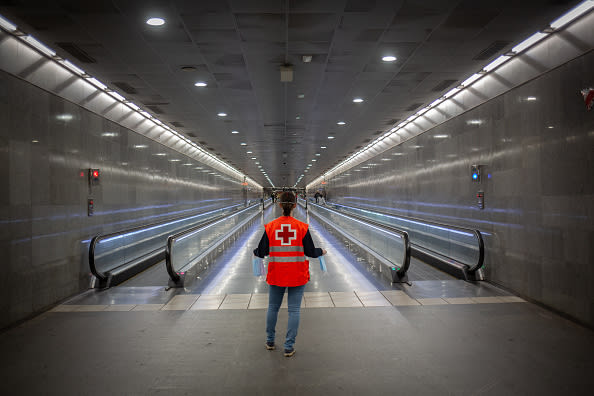
- A global public health crisis has meant countries around the world have effectively had to shut down, with many governments imposing draconian measures on the lives of billions of people.
- Some European countries have laid out plans to emerge from lockdown as soon as this month after enduring several weeks of stringent social and economic restrictions.
- "Our global connectedness means the risk of re-introduction and resurgence of the disease will continue," Tedros Adhanom Ghebreyesus, director general of the WHO, said at a media briefing on Monday.
A Red Cross volunteeer delivers mask to commuters at Diagonal station on the first working day in Cataluña after Easter holidays and the reactivation of non-essential work activity in companies whose employees cannot telework during the coronavirus crisis, on April 14, 2020 in Barcelona, Spain.David Zorrakino | Europa Press via Getty Images
The World Health Organization has identified six criteria for countries looking to slowly lift coronavirus lockdown measures, warning the way down from the peak of the outbreak is "much slower" than the way up.
A global public health crisis has meant countries around the world have effectively had to shut down, with many governments imposing draconian measures on the lives of billions of people.
The social and economic restrictions, which range from school closures to social distancing and bans on public gatherings, were brought in to try to slow the spread of the coronavirus pandemic.
As of Tuesday, nearly 2 million people had contracted Covid-19 worldwide, with 119,818 deaths, according to data compiled by Johns Hopkins University.
Some European countries have laid out plans to emerge from lockdown as soon as this month after enduring several weeks of stringent social and economic restrictions.
The U.S., the global epicenter of the coronavirus outbreak, has signaled May 1 as a potential date for easing restrictive measures.
World Health Organization (WHO) Director-General Tedros Adhanom Ghebreyesus attends a daily press briefing on COVID-19, the disease caused by the novel coronavirus, at the WHO heardquaters in Geneva on March 11, 2020.Fabrice COFFRINI | AFP | Getty Images
"These decisions must be based first and foremost on protecting human health, and guided by what we know about the virus and how it behaves," Tedros Adhanom Ghebreyesus, director general of the WHO, said at a media briefing on Monday.
"We're all learning all the time and adjusting our strategy, based on the latest available evidence. We can only say what we know, and we can only act on what we know."
Risk of a resurgence of the disease 'will continue'
Tedros said each government must assess their own respective situation, while protecting all their citizens and especially the most vulnerable.
He went onto outline a checklist that the United Nations health agency had devised for countries considering whether to lift some lockdown measures.
- First, transmission of the coronavirus must be controlled.
- Second, that health system capacities are in place to detect, test, isolate and treat every case and every contact.
- Third, that outbreak risks are minimized in special settings like health facilities and nursing homes.
- Fourth, that preventive measures are in place in workplaces, schools and other essential places.
- Fifth, that importation risks can be managed.
- And sixth, that communities are fully educated, engaged and empowered to adjust to the "new norm."
The WHO said that evidence from several countries around the world was giving them a "clearer picture about this virus, how it behaves, how to stop it and how to treat it."
It highlighted the fact that in some countries, reported cases of Covid-19 infections were doubling every three to four days. Yet, while the disease accelerates very fast, it decelerates much more slowly.
"Our global connectedness means the risk of re-introduction and resurgence of the disease will continue," Tedros said.
"Ultimately, the development and delivery of a safe and effective vaccine will be needed to fully interrupt transmission," he added.
'Walking the tightrope'
Earlier this month, Danish Prime Minister Mette Frederiksen announced care centers and schools would reopen from April 15, allowing parents to return to a normal workday.
Austria, Norway and the Czech Republic have also announced plans to slowly relax national lockdowns later this month, seeking to pave the way for a return to normal life and tentatively elevating hopes of a possible exit strategy to the pandemic.
Denmark's Frederiksen described the move as "a bit like walking the tightrope."
"If we stand still along the way we could fall and if we go too fast it can go wrong. Therefore, we must take one cautious step at a time," she added.
Denmark's Prime Minister Mette Frederiksen addresses a press conference on the novel coronavirus COVID-19 at the State Department in Copenhagen, Denmark on April 6, 2020.PHILIP DAVALI | Ritzau Scanpix | AFP via Getty Images
Separately, Germany's Health Minister Jens Spahn told CNBC's "Closing Bell" on Monday that the country was considering how to implement a gradual recovery from the pandemic.
"We are thinking about step by step, that is important … going back to a new normal," Spahn said.
VIDEO3:2003:20The average investor should be doing this during the coronavirus economic crisisInvest in You: Ready. Set. Grow.
Source: cnbc.com

